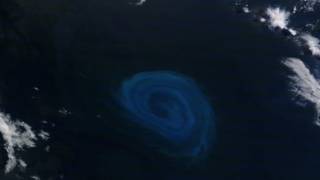Ocean currents likely to carry oil to Atlantic
Source: youtube.com
A detailed computer modeling study released today indicates that oil from the massive spill in the Gulf of Mexico might soon extend along thousands of miles of the Atlantic coast and open ocean as early as this summer (see http://www2.ucar.edu/news/ocean-curre... ). The modeling results are captured in a series of dramatic animations produced by the National Center for Atmospheric Research (NCAR) and collaborators.
The colors represent a dilution factor ranging from red (most concentrated) to beige (most diluted).
The simulations do not make any assumptions about the daily rate or total amount of oil spilled and the dilution factor does not attempt to estimate the actual barrels of oil at any spot. Instead, one unit per day of a liquid "dye tracer" is injected in the model at the spill site (injected continuously over the period April 20 through June 20). The animation on this page shows possible scenarios of what might happen to dye released in the upper 65 feet of ocean at the spill site. The dilution factor depicts how dye released at the site of the spill will be progressively diluted as it is transported and mixed by ocean currents. For example, areas showing a dilution factor of 0.01 would have one-hundredth the concentration of oil present at the spill site.
The animation is based on a computer model simulation, using a virtual dye, that assumes weather and current conditions similar to those that occur in a typical year. It is one of a set of six scenarios (see http://www2.ucar.edu/news/oil-spill-a... ) that simulate possible pathways the oil might take under a variety of oceanic conditions. Each of the six scenarios shows the same overall movement of oil through the Gulf to the Atlantic and up the East Coast. However, the timing and fine-scale details differ, depending on the details of the ocean currents in the Gulf. (Visualization by Tim Scheitlin and Mary Haley, NCAR; based on model simulations.)
A Google Earth visualization was released on June 17, 2010, with a 0.0005 concentration cutoff. The YouTube version is here: http://www.youtube.com/watch?v=2DS6sm...






















